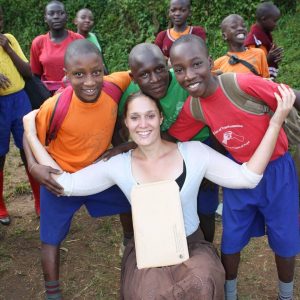Scrapes and Bruises
 By Marissa Swanson, former REACH Coordinator
By Marissa Swanson, former REACH Coordinator
Scrapes and bruises are a normal part of growing up. Kids explore, try new things, and sometimes exceed their limits, leading to unintentional injuries. The difficult task for parents and child caregivers is to allow children the freedom to explore and learn without being at risk of serious injury. Keeping children safe is particularly difficult in a complex environment like rural Uganda, where REACH operates. Many families have six or more children who are often alone or supervised by older siblings while walking to school, working on the farm, or playing around the house. The harshness of growing up in this environment is visible in the scars of the children at REACH’s primary school and outreach schools. A boy with burn marks across his face from crawling in a pot of boiling milk at 6 months of age. A girl who sliced open her leg using a machete to cut grass for her family’s cows. A boy who lost his arm and leg to an animal attack. A girl nearly killed as she chased her ball into the road. The stories – and the scars – are endless.
In response, government education officials and teachers have incorporated lessons on safety into the Ugandan school curriculum, but as with most subjects, schools often lack the resources to help them teach these important lessons. This is where my project at REACH comes in. After spending two years working for REACH as the Volunteer and Outreach Coordinator, I arrived at the University of Alabama at Birmingham ready to get my degree in Medical/Clinical Psychology, but with the hope of continuing to serve low income countries. Working with Dr. David Schwebel and the UAB Youth Safety Lab, we received the Lizette Peterson-Homer Injury Prevention Award from The Society of Pediatric Psychology and the American Psychology Foundation. This grant allowed us to collaborate with Ugandan educators to develop a teacher-led, classroom-based intervention to train P1 (first grade) students in personal safety and P6 (sixth grade) students in child supervision. The goal of the program is to reduce a wide range of the most common and severe childhood injuries including falls, cuts, burns drownings, traffic crashes, poisoning, and animal attacks. With additional support from REACH, the Moses Sinkala Travel Scholarship, and the Ireland Research Travel Award, I was able to return to Bududa this summer ready to take on the threat of childhood injuries.
In order to carry out this ambitious project which included over 400 students and more than 180 parents, we assembled a top-notch team of nine REACH university students who received training in research methods and assisted with data collection. The UAB Youth Safety Lab manager Anna Johnston also lent her administrative research expertise and joined the team in Uganda. Eight teachers at three schools received training in the safety program and delivered the lessons over three weeks. They also provided valuable feedback on the materials which we are continuing to improve for future use. We are now in the long process of scoring, entering, and analyzing our data to determine if students do indeed learn and adopt safer behaviors after receiving these safety lessons. If the program is effective, our goal is make it an affordable and widely available resource for Ugandan teachers.
Returning to Uganda after 11 months away felt like returning home. The REACH family and Bududa community welcomed me with the same hospitality and warmth I had received every day when I was living and working at REACH. Maayi Jennipher is still my Ugandan mother, the teachers are still dear friends, my sponsor children are still my special kiddos. Even the challenges were the same – dusty roads, impassably wet roads, power outages, broken generators, malfunctioning printers and copiers, dropped calls, feeble internet. But the resilience, problem-solving, flexibility, understanding and support of the REACH community always triumphed, and always will. Even faced with the harshest of circumstances, Ugandans persist onward, which is why I am confident that together we can reduce childhood injuries, one child and one class at a time.